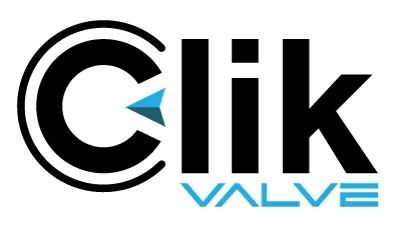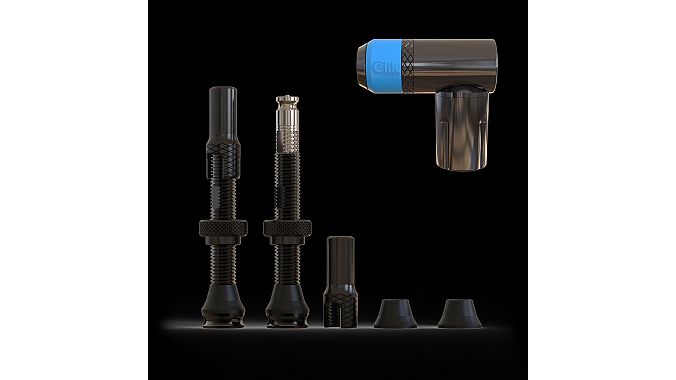A version of this feature ran in the July issue of BRAIN.
WESTLAKE VILLAGE, Calif. (BRAIN) — Fax machines and flip phones are yesterday's technology to most, but for those still using them, there's comfort in their familiarity.
John Quintana understands. He spent several years focusing on upgrading one of this industry's oldest and most overlooked standards: Presta and Schrader inflation valves and the pump heads that affix to them. The valves have been around since the 1890s, but unlike faxes and flip phones, they've been pretty much forgotten — with their shortcomings universally accepted — until now.
Quintana's Clik Valve system is backward compatible and claimed to have 1 ½ times the flowrate of a standard Presta valve, allowing tubeless setup with a standard floor pump. The Clik Valve head, which can be fitted to a standard pump, is designed without a lever and allows for push-on, pull-off, two-finger operation. A standard pump head can still be used on Clik Valves but at a reduced flowrate. The cores can be purchased separately and fitted into any Presta tube or tubeless stem.
"One of the most surprising things I learned was just how emotionally attached people are to what they already know, even if it is flawed," Quintana said when asked about what he discovered during the creative process. "There is a kind of comfort in the familiar, and that makes it hard to introduce something new, even when the benefits are obvious. Early on, I thought the technical advantages of Clik would speak for themselves. But I learned quickly that even the best ideas need to be framed in a way that makes people feel comfortable switching."
Schwalbe gets involved
It's not blowing hot air to say Clik Valve is catching on. Schwalbe was the first company to collaborate with Quintana and has since become a licensee, particularly for aftermarket European distribution. "Their support has been critical in helping Clik gain traction in the industry, but they do not hold equity in the company," Quintana said.
Since then, Lezyne and SKS have launched Clik Valve pumps and Wolf Tooth offers Clik Valve tubeless stems, pumps and pump heads. "We are actively in talks with several major tire companies. There is naturally some hesitation because of the exclusivity, which is understandable. That said, I believe we will be able to announce more partnerships this year. By next year, I expect you will see several other major brands offering products equipped with Clik Valve."
Similar to seating a tubeless tire with a standard floor pump for the first time, Quintana struggled initially attracting industry interest. In 2022, he attended the Sea Otter Classic to pitch Clik Valve.
"I had no idea what I was doing, and honestly, some days I still feel that way," Quintana said lightheartedly. "My plan was simple. I would walk around to every tire brand's booth and try to talk to someone, ideally a product manager. I will not name names, but I visited all the major booths and was politely ignored. A few people told me it was a clever idea, but that changing the valve standard was impossible. Toward the end of the show, I walked into the Schwalbe booth and, by complete luck, met one of their product and race managers. I found out later that he was not even supposed to attend the show. Fortunately, he saw the potential right away and was genuinely excited by the design."
Then Schwalbe senior management reached out.
"I knew that if Clik was going to have a real chance to reach the mainstream, it would take significant investment. That was something I did not have. Schwalbe had the resources, the reputation, and the distribution network that could make it possible. In exchange for their early commitment, we agreed to an exclusive for aftermarket sales in Europe."
Investor interest
At this stage, Clik Valve is privately held, but Quintana has had interest from investors in the cycling and mobility sectors. "We're exploring opportunities as we scale," he said. "Right now, we're focused on growing through strong product partnerships and licensing agreements, but outside investment is definitely something we are considering for the next phase of growth."
While enjoying the sport but not a daily rider, Quintana's desire to redesign the inflation valve had little to do with cycling. Before COVID-19 began, he recounted having difficulty inflating the tires of his son's electric dirt bike. The pump head didn't fit in the tight space and another pump that almost did had a lever that interfered.
"We ended up pulling the valve outward at an angle, which tore the inner tube. Born from that frustration I saw the opportunity for a quick-connect tire valve. I started with the design for the Schrader adapter and with equal importance a complementary pump head that would simply push on and pull off. The main goal was to get rid of the awkward lever arms on traditional pump heads and reduce the size."
Background in analytical science
Quintana always has been analytically inclined. For nearly 15 years, Quintana worked in the analytical science field, specifically in small molecule analysis, essentially the detection and quantification of trace chemicals, mostly organic, in gases, liquids, and solid materials.
"In this role, I was involved throughout the development process of technologies that manage the extraction, enrichment, and delivery of chemicals to various mass analyzers. It sounds fancy, but you can think of it like ultra-precise plumbing on a miniature scale. You're dealing with tiny amounts of fluids or gases moving through tubes, valves, columns, filters, and flow paths, and precision is everything."
With that kind of background, improving air flow to bike tires would seem to be elementary.
"The key differentiator is the change of the sealing location from the outside of the valve stem to the inside, which dramatically reduces the pressure forces acting upon both components," Quintana said. "Since force equals pressure times area, making a seal on the outside would require too much holding force for a smooth push/pull mechanism. Sealing inside the stem makes the whole mechanism more user-friendly and safer. All it takes is two fingers to connect/disconnect."
Presta simply outdated
He said Presta and Schrader valves are simply not designed for the demands of modern bikes. Presta valves are fragile, he said, prone to sealant clogging in tubeless setups, and can have issues with accurate pressure gauge readings. "I suppose I should really thank whoever decided to put them on mountain bikes, because that really helped to create a market for Clik."
While more robust, Schrader valves, according to Quintana, are bulky with an awkward interface connection.
Quintana initially put his idea on the shelf, but when COVID drove interest in bikes to boom levels, he resumed working on developing Clik Valve into a commercial product.
"On the technical side, I gained a deep appreciation for how much small design decisions affect usability and performance," he said. "Something as simple as changing the angle of a taper or the position of a seal could dramatically improve or completely break the user experience. It taught me not to overlook the little things and to obsess over every detail. I also learned a lot about manufacturing and scaling. Designing a great product is one thing. Designing a great product that can be made consistently, affordably, and at volume is a completely different challenge."
Quintana has partnerships with manufacturers in Italy for the valve cores and Taiwan for the pump head and related adapters. With an MSRP of $12 for a pair of cores and $14 for the pump head adapter, it's a step up in price from standard valves, which can be found online in packs of 10 for less. But Quintana notes standard Presta valves have been mass-produced for decades by specialized machines, tooling, and longtime production volumes.
"We are just getting started. There is no doubt the cost will come down over time as volume increases and production becomes more efficient." Not only a replacement, Quintana markets Clik Valve as a performance upgrade.
"This is not just a different valve; it is a better one. Whether you are running tubeless tires or just want something more reliable and intuitive, the difference is noticeable right away. And what we have seen so far is that once someone tries it, they understand the value. It is hard to go back to the old system once you have used something that just works better."




